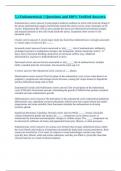5.) Endometriosis || Questions and 100% Verified Answers.
Endometriosis correct answers Gynecological medical condition in which cells from the lining of
the uterus (endometrium) appear and flourish outside the uterine cavity, most commonly on the
ovaries. Endometrial-like cells in areas outside the uterus are influenced by hormonal changes
and respond similarly to the cells found inside the uterus. Symptoms often worsen w/ the
menstrual cycle.
Ovaries correct answers A recent major study has found that endometriosis is strongly associated
w/ certain types of cancer of the _____.
Increased correct answers Factors associated w/ a(n) _____ risk of endometriosis: nulliparity,
prolonged exposure to endogenous estrogen, late menopause, shorter menstrual cycles (< 27
days), heavy menstrual bleeding, obstruction of menstrual outflow (e.g., Mullerian
abnormalities), exposure to diethylstilbestrol in utero.
Decreased correct answers Factors associated w/ a(n) _____ risk of endometriosis: multiple
births, extended intervals of lactation, late menarche (after age 14)
3 correct answers The endometrial cycle consists of ___ phases.
Menstruation correct answers The first phase of the endometrial cycle; occurs when there is no
pregnancy; progesterone and estrogen levels decrease, causing the corpus luteum to degenerate
and the endometrial lining cells to shed.
Endometrial Growth and Proliferation correct answers The second phase of the endometrial
cycle; FSH and LH secretion increase, stimulating the growth of follicles that produce estradiol;
estradiol increases endometrium growth.
Differentiation correct answers The third phase of the endometrial cycle; endometrial epithelium
differentiates into a glandular secretory phenotype; follicle turns into corpus luteum that makes
progesterone and some estradiol; these hormones stimulate the endometrium to develop
secretory glands.
Superficial Peritoneal; Glandular; Stromal correct answers While _____ lesions classically
contain endometrial glands and stroma, the _____ component can be absent, sparse, or
transformed by hormonal and metaplastic changes or cellular atypia. The _____ component can
be obscured by infiltrates of foamy and pigmented histiocytes, fibrosis, or other processes.
Endometrioma correct answers An ovarian cyst formed when ectopic endometrial tissue within
the ovary bleeds and results in a hematoma surrounded by duplicated ovarian parenchyma. Both
ovaries are involved in 1/3 of cases. In contrast w/ most hemorrhagic ovarian cysts, these
typically have fibrotic walls and surface adhesions, and they are filled w/ syrup-like chocolate-
colored material, as a result of blood oxidation.
, Deeply Infiltrating Endometriosis correct answers AKA DIE; defined as a solid endometriosis
mass situated more than 5 mm deep to the peritoneum (the serous membrane lining the cavity of
the abdomen and covering the abdominal organs).
Cysts; Infertility correct answers In cases of endometriosis, blood doesn't exit the body via the
vaginal canal and becomes trapped, forming _____, leading to scar tissue and adhesions, thus
resulting in _____.
Pain correct answers In cases of endometriosis, blood doesn't exit the body via the vaginal canal
and becomes trapped, which can irritate the surrounding tissue, leading to _____.
Adhesions; Inflammation correct answers In endometriosis, chronic pelvic pain can result from
_____ and ______.
Dysmenorrhea correct answers Painful menstrual cycle; subtype of pelvic pain associated w/
endometriosis.
Dyspareunia correct answers Painful sexual intercourse; subtype of pelvic pain associated w/
endometriosis.
Dysuria correct answers Painful urination; subtype of pelvic pain associated w/ endometriosis.
Constipation correct answers Symptom of endometriosis; difficulty passing stool.
True correct answers True/False: Chronic fatigue is a symptom of endometriosis.
Complications of Endometriosis correct answers Cysts, scarring, fibrosis, adhesions, abscess,
peritonitis, bowel obstruction, bladder problems.
Dyspareunia correct answers Peritoneal or DIE pts. often present w/ _____.
Uterosacral; Cardinal; Pouch; Posterior; Anterior correct answers DIE lesions can occur on the
_____ and _____ ligaments, _____ of Douglas, _____ vaginal fornix, and the _____ rectal wall.
Superficial correct answers Introital, or _____, dyspareunia can result from lesions of the cervix,
hymen, perineum, and episiotomy scars.
Bladder correct answers _____ endometriosis typically presents w/ nonspecific urinary
symptoms or frequency, urgency, and pain at micturition. Symptoms can be worsened w/
menses.
Ureteral correct answers _____ endometriosis can be asymptomatic or associated w/ colicky
flank pain or gross hematuria.




